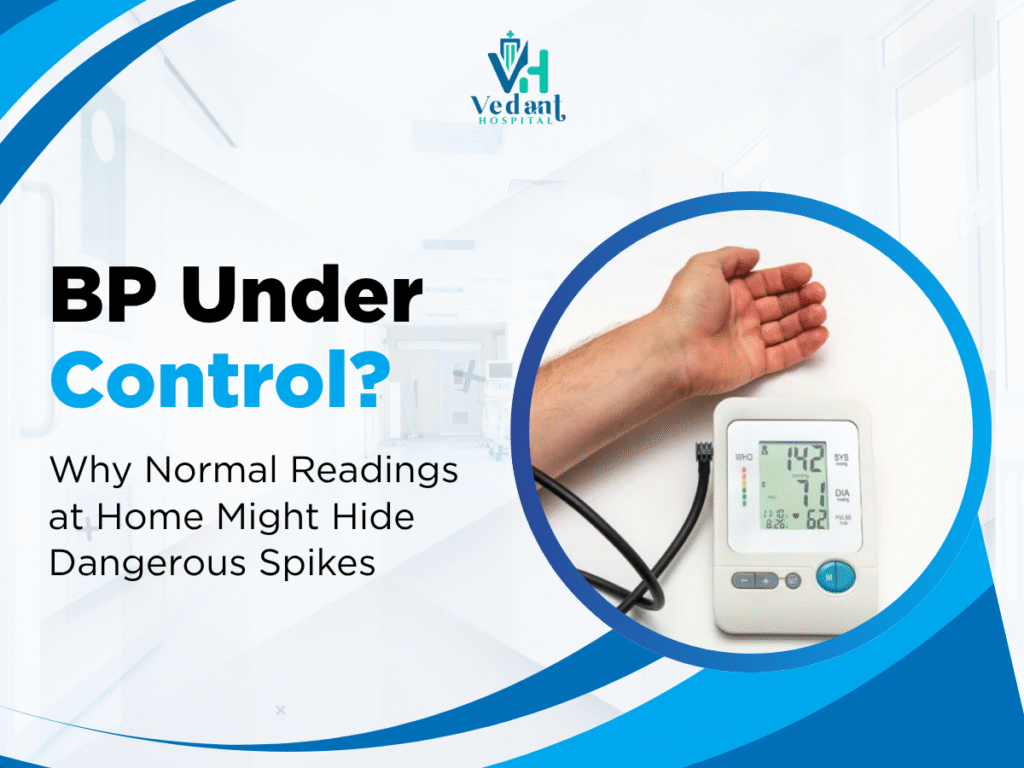You check your blood pressure at home regularly. The readings look fine. So you assume everything’s okay, right?
But here’s the truth: Just because your BP is “normal” at home doesn’t mean it stays that way all the time. Dangerous spikes in blood pressure can happen silently—without symptoms—and may only show up during activity, stress, or even while you sleep.
This blog helps you understand the risks of hidden blood pressure fluctuations, when to worry, and how regular check-ups at a reputed hospital in Gwalior can make all the difference in protecting your heart and brain.
1. The Silent Risk: What Is Masked Hypertension?
When your BP looks normal—but isn’t
Masked hypertension is a condition where blood pressure readings are normal at home but elevated in clinical or real-life settings. It’s more common than you think and increases your risk of:
- Heart attack
- Stroke
- Kidney damage
- Eye problems
2. Why BP Spikes Might Go Unnoticed at Home
Common causes of inaccurate “normal” readings
- You’re relaxed at home (which lowers BP temporarily)
- Readings are taken at only one time of day
- Faulty or outdated BP monitors
- Not following proper measuring posture or timing
3. Dangers of Uncontrolled Spikes Despite “Normal” BP
Even if your average reading is okay, short-term spikes can damage blood vessels over time. They’re linked to:
- Sudden strokes
- Silent heart damage
- Memory loss and dementia
Routine screenings at a certified hospital in Gwalior using 24-hour ambulatory BP monitoring can catch these hidden fluctuations.
4. How to Detect and Manage Hidden BP Fluctuations
Actionable tips to protect your heart and brain
Track your BP at different times:
- Morning (before meds)
- Evening (post-work)
- During symptoms (headache, anxiety, chest discomfort)
Use proper technique:
- Sit straight, feet flat
- Avoid caffeine 30 minutes before
- Rest for 5 minutes before measuring
Visit a cardiologist:
- Ask about ambulatory BP monitoring (ABPM)
- Review your meds and lifestyle
FAQs on BP Spikes and Masked Hypertension
Q1. If my BP is normal at home, should I still worry?
Yes. Home monitors can miss spikes. If you have risk factors, get checked clinically.
Q2. What are the signs of a BP spike?
Often there are none. Some feel headaches, dizziness, or anxiety—but many remain symptom-free.
Q3. Can stress cause BP spikes?
Absolutely. Emotional stress is one of the most common causes of short-term BP elevation.
Bonus Tips to Keep BP Truly Under Control
- Reduce sodium and processed food intake
- Exercise at least 30 minutes a day
- Get quality sleep (6–8 hours)
- Avoid excessive caffeine or alcohol
- Meditate or try deep breathing to reduce stress
- Consult your doctor before adjusting medication
Why Regular Check-Ups at a Hospital Matter
While home monitoring is useful, only a full clinical assessment can reveal the real picture. At a reputed hospital in Gwalior, you can:
- Get advanced cardiac testing
- Detect masked or white-coat hypertension
- Prevent serious complications early
Don’t let silent spikes go undetected. Protect your heart—get expert evaluation today.
Conclusion: “BP Under Control” Isn’t Always the Full Story
Blood pressure that seems normal at home can be dangerously misleading. Masked hypertension and BP spikes are serious health risks that demand attention.
Final tip? Don’t rely solely on home readings. Get clinically evaluated at a trusted hospital in Gwalior and take control of your health—before a hidden spike causes real harm.


